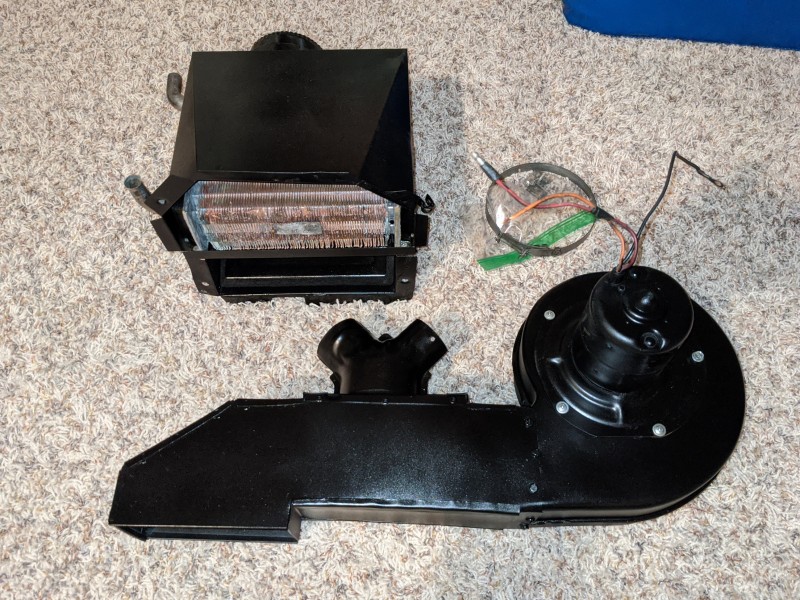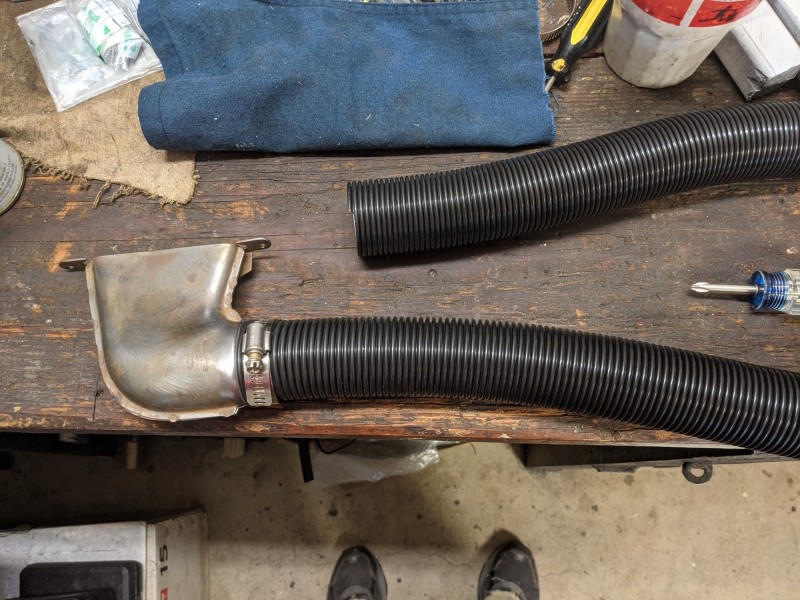The sbc283 in the wagon is quite tired....and while I've got it running reliably (spark and fuel etc), the compression is low and oil consumption is high, as well as leaky gaskets and seals everywhere that I think are mostly due to crankcase pressure (no PCV - just a road draft tube). Anyway, I am happy to keep driving it around town as is - just have to keep up with adding oil every couple fill ups - but also recognize for it to be more than just an around town 'go getter' etc, its going to need some help in the engine dept. So this is the plan:
![[IMG] [IMG]](https://beamingpix.com/images/2020/09/26/PXL_20200926_235839046.jpg)
I do really like some aspects of the 283 - and if it were in good shape, I would have just kept using it. But the 283 is a short stroke, high rpm engine that is pretty gutless below 1500rpm, and doesn't really wake up and pull until 2000rpm. So it just doesn't seem worth putting money into a rebuild of an engine that I didn't think would ever be that great on the low end torque needed for my intended usage or interest. I do worry a 350 could be too much motor, and in a perfect world a 305 or 327 might have been better, but the price and history (hopefully) for this one was right. While the T90 is a potentially a bit weak for a sbc350, the plan is to keep the build completely 1970s oem truck build, and to drive it with awareness. The placement of the engine is not ideal as it uses the front cradle mount on the OEM L6 engine mounts - the engine is crammed up against the firewall. So if/when the transmission needs to get swapped, new engine placement and cross-members can all be done at that time....but I want to do it in small steps with driveable time in between. I think the D18 and D44 should be able to stand up to some use, and the D25 can be babied a bit when in 4wd lo. No intention to put traction devices in the axles, so that also helps keep from abusing them....I will say, I bought this wagon specifically because it already had some swapping and modifications done and thought it would be a more useful driver on a more frequent basis (and I would be more free to modify without regret...but I am also learning that I really do lean more towards stock configuration with limited, purposeful and maybe even subtle upgrades (the cj5 is mostly stock minus lift and tires, and Tera low gears hidden in the D18 and a locker hidden in the D44). I feel like with each discussion of swapping out another piece, I am killing the soul of the wagon....but in the the end, keeping it on the road and driving it lots will hopefully make up for it.
Not the wagon exactly, but am making a bit of progress with the sbc350 that is hopefully going to find its way into the wagon in place of the sbc283....
The hope is just basic disassembly and inspection, cleaning, re-assembly with new seals, gaskets etc...The idea is NOT to go the full rebuild route, as it would then just have been cheaper to buy a crate engine....so we'll see what kind of trouble I have gotten myself into here....I've never done this kind of engine work before.
Got the intake and heads off...no obvious ridge at the top of the cylinders, and no immediately obvious issues with the cylinders that I can see so far.....here are some pictures...
passenger bank:
cylinders 2 and 4:
cylinder 3:
Had a lot of carbon build-up in the heads and valves:
Here was the worst valve in terms of carbon build-up....I think this was #5...
But a lot of cleaning and lapping - I like how the intake valves look, and I think I got the seats looking better. The exhaust seats were better than the intake seats to start, and look pretty good now, but the intake valves are still rough even after a lot of compound work. But at some point, seemed it was as good as it was going to get and decided to test them....hard to see it, but the closest combustion chamber (#2) here is full of water....its not perfectly water tight, but its only a couple seepy 'drips' over 10 min or so...I think (hope) its good enough...
![[IMG] [IMG]](https://beamingpix.com/images/2020/10/14/PXL_20201015_005430913.jpg)
its mostly the #3 cylinder that is a problem in terms of getting decent valve seats. I feel like if I lap them anymore, I am going to cause a problem with the valves themselves. And I would possibly consider new exhaust valves...all the intake valves came out nice. But we are going to go with it as is....cleaned up and ran a tap through all the threads etc, and since I don't like painted gaskets, I am going to try painting as many of the pieces individually as I can each step of the way before assembly.
Finished cleaning, painting and putting the valves and springs back in the heads...guess I could put the rocker arms on now as well, but seems its much easier to access the head bolts for mounting back to the block without them...so about to put these aside for a bit and get the bottom end cleaned up and ready...
I used these umbrella seals for intake valves:
and these for the exhaust valves:
Put o-rings on the second (lower groove) for all the valves, and then put the retainers in the upper groove with the help of a valve spring compressor:
Finished up:
In reality, the heads probably should have had a professional valve job with grinding valve seats etc, and then new valves would have been a good idea, and then its hard to know where to stop, and you end up with a complete rebuild (never a bad idea), but I am going total budget....as I told my friends, I am channeling my rural southern heritage, drinking Budweiser and and slapping this thing back together essentially as is....









![[IMG] [IMG]](https://beamingpix.com/images/2020/09/14/IMG_20200914_103525.jpg)
![[IMG] [IMG]](https://beamingpix.com/images/2020/09/17/IMG_20200917_202804.jpg)
![[IMG] [IMG]](https://beamingpix.com/images/2020/09/17/IMG_20200917_175317.jpg)
![[IMG] [IMG]](https://beamingpix.com/images/2020/09/17/IMG_20200917_202940.jpg)

![[IMG] [IMG]](https://beamingpix.com/images/2020/09/22/IMG_20200922_083121.jpg)
![[IMG] [IMG]](https://beamingpix.com/images/2020/09/22/IMG_20200922_121743.jpg)
![[IMG] [IMG]](https://beamingpix.com/images/2020/09/22/IMG_20200922_121758.jpg)
![[IMG] [IMG]](https://beamingpix.com/images/2020/09/22/IMG_20200922_142400.jpg)
![[IMG] [IMG]](https://beamingpix.com/images/2020/09/22/IMG_20200922_162141.jpg)
![[IMG] [IMG]](https://beamingpix.com/images/2020/09/22/IMG_20200922_162109.jpg)
![[IMG] [IMG]](https://beamingpix.com/images/2020/09/22/IMG_20200922_162152.jpg)
![[IMG] [IMG]](https://beamingpix.com/images/2020/09/22/IMG_20200922_180319.jpg)
![[IMG] [IMG]](https://beamingpix.com/images/2020/09/22/IMG_20200922_174824.jpg)
![[IMG] [IMG]](https://beamingpix.com/images/2020/09/26/PXL_20200926_235839046.jpg)

![[IMG] [IMG]](https://www.beamingpix.com/images/2020/10/07/PXL_20201008_031010325.jpg)
![[IMG] [IMG]](https://www.beamingpix.com/images/2020/10/07/PXL_20201008_031040563.jpg)
![[IMG] [IMG]](https://www.beamingpix.com/images/2020/10/07/PXL_20201008_031109364.jpg)
![[IMG] [IMG]](https://www.beamingpix.com/images/2020/10/08/PXL_20201008_182350905.jpg)
![[IMG] [IMG]](https://www.beamingpix.com/images/2020/10/08/PXL_20201008_182405799.jpg)
![[IMG] [IMG]](https://beamingpix.com/images/2020/10/14/PXL_20201011_161853871.jpg)
![[IMG] [IMG]](https://beamingpix.com/images/2020/10/14/PXL_20201015_005430913.jpg)
![[IMG] [IMG]](https://beamingpix.com/images/2020/10/22/PXL_20201023_000111145.jpg)
![[IMG] [IMG]](https://www.beamingpix.com/images/2020/10/28/PXL_20201028_230030155.jpg)
![[IMG] [IMG]](https://www.beamingpix.com/images/2020/10/28/PXL_20201029_010127256.jpg)
![[IMG] [IMG]](https://www.beamingpix.com/images/2020/10/28/PXL_20201028_231647997.jpg)
![[IMG] [IMG]](https://www.beamingpix.com/images/2020/10/28/PXL_20201029_012738509.jpg)
![[IMG] [IMG]](https://www.beamingpix.com/images/2020/10/28/PXL_20201029_025114332.jpg)
![[IMG] [IMG]](https://www.beamingpix.com/images/2020/10/28/PXL_20201029_025054052.jpg)
![[IMG] [IMG]](https://www.beamingpix.com/images/2020/10/30/PXL_20201030_174502826.jpg)
![[IMG] [IMG]](https://www.beamingpix.com/images/2020/10/29/PXL_20201029_235418375.jpg)
![[IMG] [IMG]](https://www.beamingpix.com/images/2020/10/30/PXL_20201030_203757080.jpg)
![[IMG] [IMG]](https://www.beamingpix.com/images/2020/10/30/PXL_20201030_203930891.jpg)
![[IMG] [IMG]](https://www.beamingpix.com/images/2020/10/30/PXL_20201030_204252822.jpg)
![[IMG] [IMG]](https://www.beamingpix.com/images/2020/10/30/PXL_20201031_001734469.jpg)
![[IMG] [IMG]](https://www.beamingpix.com/images/2020/10/30/PXL_20201031_002958816.jpg)
![[IMG] [IMG]](https://www.beamingpix.com/images/2020/10/30/PXL_20201031_003219686.jpg)
![[IMG] [IMG]](https://www.beamingpix.com/images/2020/10/30/PXL_20201031_004049634.jpg)
![[IMG] [IMG]](https://www.beamingpix.com/images/2020/10/30/PXL_20201031_004349926.jpg)